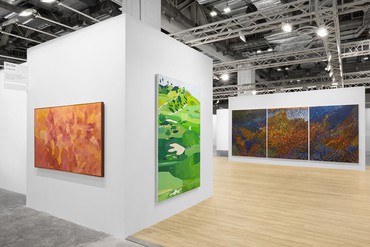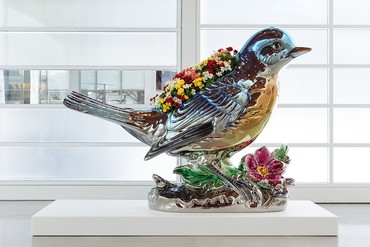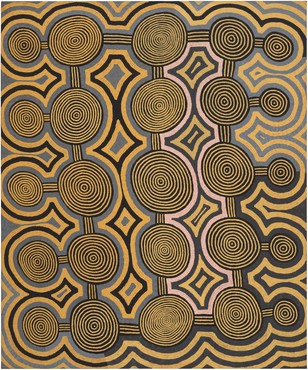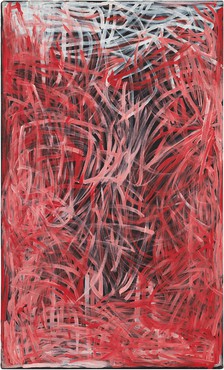About
Indigenous Australians constitute the longest surviving civilization in human history, one that dates back more than 60,000 years. Among Australia’s most revered artists, Emily Kame Kngwarreye (1910–1996), or Emily, as she became widely known, grew up in the remote central desert region of Utopia, where she had only sporadic contact with the world beyond her own community. While working as a stockhand, she developed her artistic skills in Utopia settlement workshops—first in traditional batik production and then painting on canvas.
While affinities may be perceived and parallels drawn between the art of the so-called Desert painters and other modern artistic idioms, their practices have developed in relative isolation and stem from the oldest continuous art traditions in the world. For Indigenous Australians, “Dreaming” is a cultural worldview that provides an ordered sense of reality, a framework for understanding and interpreting the world and the place of humans within it. This precious knowledge of human life includes survival strategies, ancestral histories, and narratives of the earth and cosmos. “Country” describes the environments that they inhabit, both physically and spiritually, and contains complex ideas about language, governance, family, and identity, among other life-determining practices.
Emily’s oeuvre was inspired by her role as an Anmatyerre elder and her custodianship of the women’s Dreaming sites in her clan Country, Alhalkere. In this cultural context, women’s lore is guarded and passed down through both storytelling and visual media, including designs painted on human bodies, traced in the earth, or carved into rock or tree bark.
Inspired by the topographies of desert and sky, the cycles of seasons, flooding waters and rains, cultivation and harvest, and spiritual forces, Emily’s paintings depict the enduring narratives and symbols of her people and their land, and the keeping of precious shared knowledge and stories. Her middle name, Kame, denotes the sustaining pencil yam and its seeds—Emily’s totem, and the motivating force of her oeuvre.
Emily is unique among Indigenous Australian painters for her rapid and systematic exploration of different styles and for her bold inventiveness with regard to form and color. She painted prolifically on both intimate and grand scales, with brushes, sticks, and fingertips on unstretched linen laid flat on the ground, sitting beside or within the composition itself.
Emily has been the subject of several museum surveys in Australia and Japan, and her work featured prominently in the 56th Biennale di Venezia in 2015.
Exhibitions
Fairs, Events & Announcements

Art Fair
ART SG 2024
January 19–21, 2024, booth BC06
Marina Bay Sands Expo and Convention Centre, Singapore
artsg.com
Gagosian is pleased to participate in the second edition of ART SG, with a selection of works by international contemporary artists including Harold Ancart, Georg Baselitz, Ashley Bickerton, Amoako Boafo, Dan Colen, Edmund de Waal, Nan Goldin, Lauren Halsey, Hao Liang, Keith Haring, Damien Hirst, Tetsuya Ishida, Alex Israel, Donald Judd, Y.Z. Kami, Emily Kame Kngwarreye, Rick Lowe, Takashi Murakami, Takashi Murakami & Virgil Abloh, Nam June Paik, Ed Ruscha, Jim Shaw, Alexandria Smith, Spencer Sweeney, Stanley Whitney, Jonas Wood, and Zeng Fanzhi. The works on view, which embrace a wide variety of subjects and approaches, find artists infusing traditional genres such as history painting, portraiture, and landscape with new and surprising ideas that traverse cultural and temporal boundaries.
Gagosian’s booth at ART SG 2024. Artwork, left to right: © ADAGP, Paris, 2024, © Jonas Wood, © Rick Lowe Studio. Photo: Ringo Cheung

In Conversation
The Global Rise of Indigenous Australian Art and Emily Kame Kngwarreye
Kelli Cole, Philippe Peltier, Hetti Perkins
Tuesday, March 15, 2022, 6am EdT (11am CET)
Join Gagosian for an online conversation with Philippe Peltier, former head of the Océania and Insulindia Unit at Musée du quai Branly–Jacques Chirac in Paris, and Australian Indigenous curators Kelli Cole and Hetti Perkins, in conjunction with the exhibition Emily: Desert Painter of Australia at Gagosian, Paris. The trio will discuss the introduction of Australian Indigenous artists to France in the context of the burgeoning global engagement with these artists and their ancient cultural traditions. Together they will also explore Emily Kame Kngwarreye’s legacy as one of the most celebrated Australian artists. To join, register at eventbrite.com.
Emily Kame Kngwarreye, Untitled – Alhalkere, 1994 © ADAGP, Paris, 2022

Art Fair
FIAC Online 2021
Printemps oublié
March 2–12, 2021
Gagosian is pleased to present Printemps oublié for the first online edition of FIAC. This curated presentation reflects the dual character of springtime as a reminder of past trials and the harbinger of a vibrant new season to come.
All the artworks will appear on the Gagosian website and a rotating selection will appear in the inaugural FIAC Online Viewing Rooms, from March 4 to 7.
Jeff Koons, Bluebird Planter, 2010–16 © Jeff Koons



